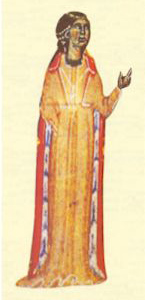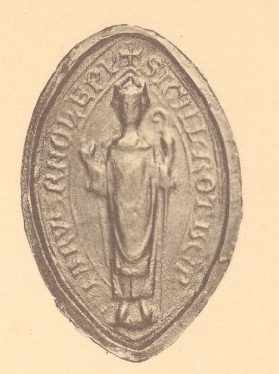|
Pons De Capdoill
Pons de Capduelh ( fl. 1160–1220Chambers 1978, 140. or 1190–1237Aubrey 1996, 19–20.) was a troubadour from the Auvergne, probably from Chapteuil. His songs were known for their great gaiety. He was a popular poet and 27 of his songs are preserved, some in as many as 15 manuscripts. Four of his ''cansos'' survive with musical notation. Biography ''Vida'' and ''razo'' There survives a ''vida'', or short biography, of Pons written by a contemporary and fellow troubadour, Uc de Saint Circ. According to Uc, Pons and troubadour Guillem de Saint Leidier were both from the diocese of Le Puy, and while Guillem was "generous with money" (''larcs donaire d'aver''), Pons was very stingy (''fort escars d'aver''). He reportedly loved Azalais, daughter of Bernard VII of Anduze and wife of Oisil de Mercoeur (or Mercuor). (Bernard of Anduze was a patron of many troubadours.) The ''vida'' states that " onsloved zalaisdearly and praised her and made many good songs about her; and as long as ... [...More Info...] [...Related Items...] OR: [Wikipedia] [Google] [Baidu] |
Peirol
Peirol or PeiròlIn Occitan, ''peir'' (French "pierre") means "stone" and ''-ol'' is a diminutive suffix, the name Peirol being understood as the equivalent of "Little Stone" but also "Petit Pierre" (Lil' Peter) or "Pierrot" (Pete or Petey); however, "peiròl" also meant a cauldron or a stove. The Occitan usually write Peiròl with an accented "ò" because "Peirol" would be pronounced . (, ; born c. 1160, fl. 1188–1222Nichols, 129./1225,Aubrey, "References to Music in Old Occitan Literature", 123. died in the 1220s) was an Auvergnat troubadour who wrote mostly ''cansos'' of courtly love in the late twelfth and early thirteenth centuries.Switten, 320. Thirty-four surviving poems written in Occitan have been attributed to him; of these, seventeen (sixteen of them love songs) have surviving melodies. He is sometimes called Peirol d'Auvergne or Peiròl d'Auvèrnha, and erroneously Pierol. Biography Not much is known of his life, and any attempt to establish his biography from a rea ... [...More Info...] [...Related Items...] OR: [Wikipedia] [Google] [Baidu] |
Trobairitz
The ''trobairitz'' () were Occitan female troubadours of the 12th and 13th centuries, active from around 1170 to approximately 1260. ''Trobairitz'' is both singular and plural. The word ''trobairitz'' is first attested in the 13th-century romance '' Flamenca''. It comes from the Provençal word ''trobar'', the literal meaning of which is "to find", and the technical meaning of which is "to compose". The word ''trobairitz'' is used very rarely in medieval Occitan, as it does not occur in lyrical poetry, grammatical treatises or in the biographies (''vidas'') of the ''trobairitz'' or troubadours.Paden It does occur in the treatise ''Doctrina d'acort'' by Terramagnino da Pisa, written between 1282 and 1296. He uses it as an example of a word the plural and singular of which are the same.Elizabeth W. Poe, "Cantairitz e Trobairitz: A Forgotten Attestation of Old Provençal »Trobairitz«," ''Romanische Forschungen'', 114, 2 (2002), pp. 206–215, at 207: "which are correctly used on ... [...More Info...] [...Related Items...] OR: [Wikipedia] [Google] [Baidu] |
Mark (currency)
The mark was a currency or unit of account in many states. It is named for the mark unit of weight. The word ''mark'' comes from a merging of three Teutonic/ Germanic words, Latinised in 9th-century post-classical Latin as ', ', ' or '. It was a measure of weight mainly for gold and silver, commonly used throughout Europe and often equivalent to . Considerable variations, however, occurred throughout the Middle Ages. As of 2022, the only circulating currency named "mark" is the Bosnia and Herzegovina convertible mark. List of currencies named "mark" or similar "Mark" can refer * to one of the following historical German currencies: ** Since the 11th century: the , used in the Electorate of Cologne; ** 1319: the , minted and used by the North German Hanseatic city of Stralsund and various towns in Pomerania; ** 1502: the , a uniform coinage for the ''Wends'' () Hanseatic cities of Lübeck, Hamburg, Wismar, Lüneburg, Rostock, Stralsund, Anklam, among others, who joined th ... [...More Info...] [...Related Items...] OR: [Wikipedia] [Google] [Baidu] |
Philip II Of France
Philip II (21 August 1165 – 14 July 1223), byname Philip Augustus (french: Philippe Auguste), was King of France from 1180 to 1223. His predecessors had been known as kings of the Franks, but from 1190 onward, Philip became the first French monarch to style himself "King of France" (Latin: ''rex Francie''). The son of King Louis VII and his third wife, Adela of Champagne, he was originally nicknamed ''Dieudonné'' (God-given) because he was a first son and born late in his father's life. Philip was given the epithet "Augustus" by the chronicler Rigord for having extended the crown lands of France so remarkably. After decades of conflicts with the House of Plantagenet, Philip succeeded in putting an end to the Angevin Empire by defeating a coalition of his rivals at the Battle of Bouvines in 1214. This victory would have a lasting impact on western European politics: the authority of the French king became unchallenged, while the English King John was forced by his barons to ... [...More Info...] [...Related Items...] OR: [Wikipedia] [Google] [Baidu] |
Pope Innocent III
Pope Innocent III ( la, Innocentius III; 1160 or 1161 – 16 July 1216), born Lotario dei Conti di Segni (anglicized as Lothar of Segni), was the head of the Catholic Church and ruler of the Papal States from 8 January 1198 to his death in 16 July 1216. Pope Innocent was one of the most powerful and influential of the medieval popes. He exerted a wide influence over the Christian states of Europe, claiming supremacy over all of Europe's kings. He was central in supporting the Catholic Church's reforms of ecclesiastical affairs through his decretals and the Fourth Lateran Council. This resulted in a considerable refinement of Western canon law. He is furthermore notable for using interdict and other censures to compel princes to obey his decisions, although these measures were not uniformly successful. Innocent greatly extended the scope of the Crusades, directing crusades against Muslim Iberia and the Holy Land as well as the Albigensian Crusade against the Cathars in southern ... [...More Info...] [...Related Items...] OR: [Wikipedia] [Google] [Baidu] |
Robert (bishop Of Clermont)
Robert of Auvergne, also called Robert de la Tour (died 7 January 1234), was a French nobleman, prelate and poet from the Auvergne. He served as bishop of Clermont from 1195 until 1227 and thereafter as archbishop of Lyon until his death. He was also a troubadour, composing poetry in Occitan. Robert was involved in several feudal conflicts between 1195 and 1211. Twice imprisoned (1199, 1207) and accused of murder and rapine, his disputes with family and vassals drew intervention from both king and pope. He emerged victorious and in control of the city of Clermont itself. He also added lands and castles to his diocese and took part in the Albigensian Crusade (1209). After his election as archbishop, he was imprisoned a third time for interfering with the marriage politics of the count of Champagne, but was soon liberated by his friends. He was less successful in Lyon, where his pontificate is marked by disputes with the rising merchant class. His health declined in his final two ... [...More Info...] [...Related Items...] OR: [Wikipedia] [Google] [Baidu] |
Bishop Of Clermont
The Roman Catholic Archdiocese of Clermont (Latin: ''Archidioecesis Claromontana''; French: ''Archidiocèse de Clermont'') is an archdiocese of the Latin Rite of the Roman Catholic Church The Catholic Church, also known as the Roman Catholic Church, is the largest Christian church, with 1.3 billion baptized Catholics worldwide . It is among the world's oldest and largest international institutions, and has played a ... in France. The diocese comprises the Departments of France, department of Puy-de-Dôme, in the Regions of France, Region of Auvergne (region), Auvergne. The Archbishop's seat is Clermont-Ferrand Cathedral. Throughout its history Clermont was the senior suffragan of the Roman Catholic Archdiocese of Bourges, Archdiocese of Bourges. It became a metropolitan see itself, however, in 2002. The current archbishop is François Kalist. At first very extensive, the diocese lost Haute-Auvergne in 1317 through the reorganization of the structure of bishopr ... [...More Info...] [...Related Items...] OR: [Wikipedia] [Google] [Baidu] |
Vertaizon
Vertaizon (; oc, Vartaizon) is a commune of the department of Puy-de-Dôme in the region Auvergne-Rhône-Alpes. It is part of the urban area of Clermont-Ferrand. Geography Location Vertaizon is built on a hill giving a view on the Limagne and Pont-du-Château from its summit, where is situated the ''ancienne église'' ("the Ancient church") and the wall from the former castle (destroyed on the orders of Cardinal de Richelieu during the 17th century). The commune stretches from the foot of the hill to the lieu-dit Chignat. History The ''foire de Chignat'' ("fair of Chignat"), former "melons' fair", is one of the oldest fairs in France: its oldest occurrence in documents is from 1303. This event takes place every year at the beginning of September in the field near the Castle of Chignat. In 1195, the lordship of Vertaizon belonged to the troubadour Pons de Chapteuil, who was eventually attacked by bishop Robert de Clermont, at war with his brother the count Guy II d'Auve ... [...More Info...] [...Related Items...] OR: [Wikipedia] [Google] [Baidu] |
Fay-le-Clos
Fay-le-Clos () is a commune in the Drôme department in the Auvergne-Rhône-Alpes region in southeastern France. Population See also *Communes of the Drôme department The following is a list of the 363 communes of the Drôme department of France. The communes cooperate in the following intercommunalities (as of 2020):Communes of Drôme {{Drôme-geo-stub ... [...More Info...] [...Related Items...] OR: [Wikipedia] [Google] [Baidu] |
Third Crusade
The Third Crusade (1189–1192) was an attempt by three European monarchs of Western Christianity (Philip II of France, Richard I of England and Frederick I, Holy Roman Emperor) to reconquer the Holy Land following the capture of Jerusalem by the Ayyubid sultan Saladin in 1187. For this reason, the Third Crusade is also known as the Kings' Crusade. It was partially successful, recapturing the important cities of Acre and Jaffa, and reversing most of Saladin's conquests, but it failed to recapture Jerusalem, which was the major aim of the Crusade and its religious focus. After the failure of the Second Crusade of 1147–1149, the Zengid dynasty controlled a unified Syria and engaged in a conflict with the Fatimid rulers of Egypt. Saladin ultimately brought both the Egyptian and Syrian forces under his own control, and employed them to reduce the Crusader states and to recapture Jerusalem in 1187. Spurred by religious zeal, King Henry II of England and King Philip II of F ... [...More Info...] [...Related Items...] OR: [Wikipedia] [Google] [Baidu] |
.jpg)
.jpg)



